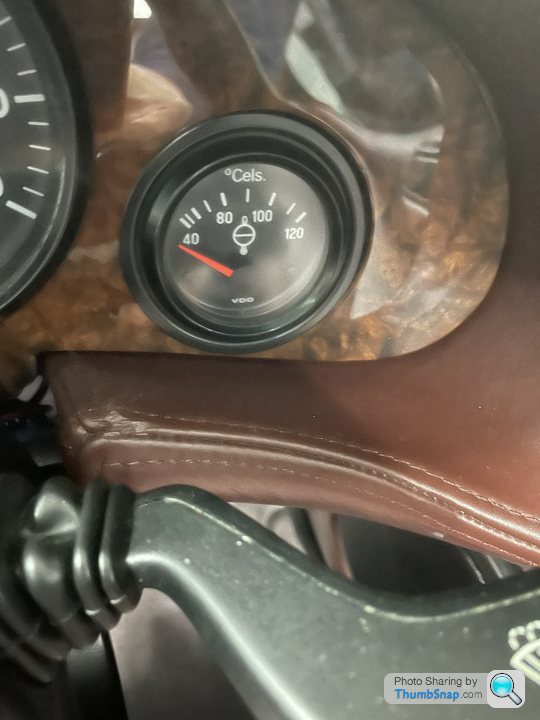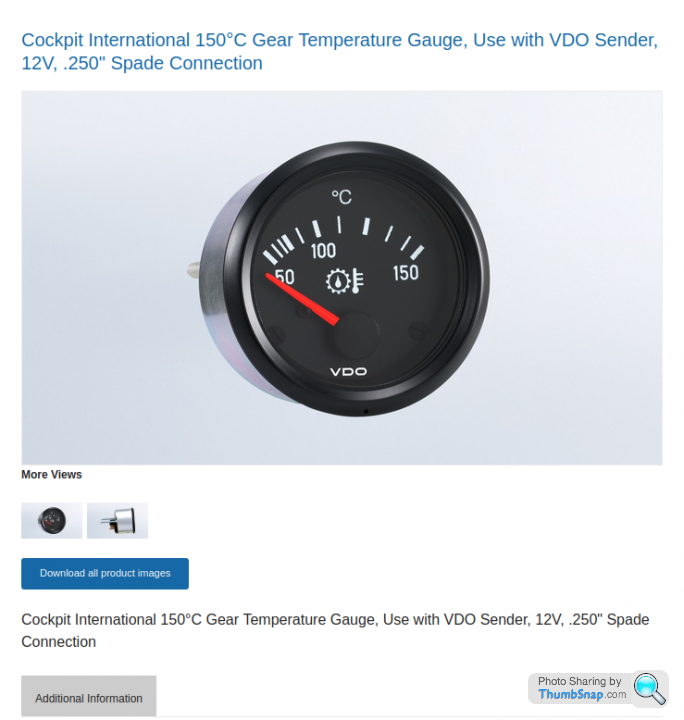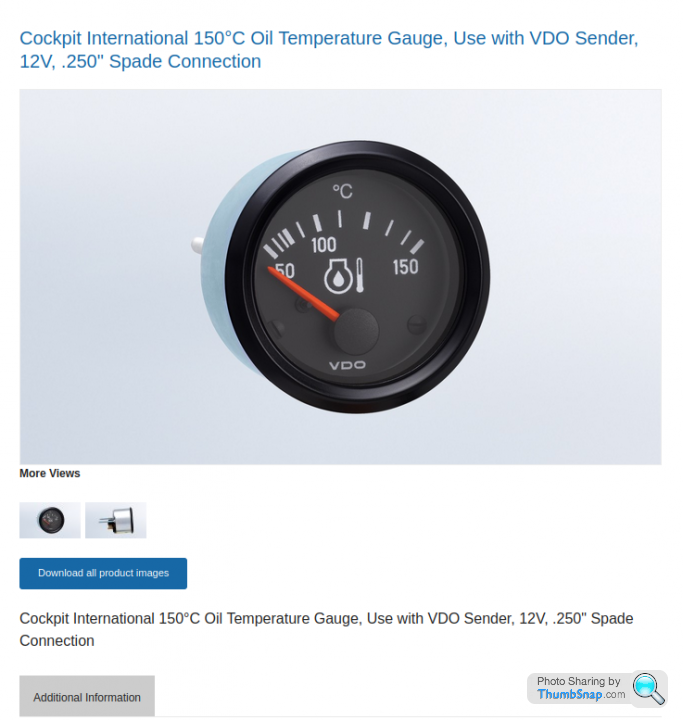Water Temperature Gauge
Discussion
My Griff has non standard BDO instruments and the water temperature gauge has started to over read (I think) so assuming it might be the sender.
Do Wedges have the VDO water temp gauge like this?

If so can anyone point me in the direction of a new VDO sender? Also are these gauges still available?
Thanks!
Do Wedges have the VDO water temp gauge like this?

If so can anyone point me in the direction of a new VDO sender? Also are these gauges still available?
Thanks!
Gauges usually work reliabale, as well as senders. its most unlikely that senders loose their callibration. senders work or they dont.
in your case i would say: the gauge shows you the correct temperature and tells you "hey, check your cooling system, there is a possible problem in the pipeline"
in your case i would say: the gauge shows you the correct temperature and tells you "hey, check your cooling system, there is a possible problem in the pipeline"
Might be worth a phone call
Website includes 2 x Celsius gauges plus sender information
Gear Temp

https://www.vdo-instruments.com/instruments/by-typ...
Oil Temp

https://www.vdo-instruments.com/instruments/by-typ...
Website includes 2 x Celsius gauges plus sender information
Gear Temp

https://www.vdo-instruments.com/instruments/by-typ...
Oil Temp

https://www.vdo-instruments.com/instruments/by-typ...
You can check the gauge, place an old! electric kettle near the sender. Remove the sender from the block and extend the wires to allow the sender to go into the water. Boil the kettle and check what the gauge reads - obviously should be close to 100degC.
If the sender has a single wire then attach (tiewrap) an earth wire to the threaded area.
If the sender has a single wire then attach (tiewrap) an earth wire to the threaded area.
Polly Grigora said:
Might be worth a phone call
Website includes 2 x Celsius gauges plus sender information
Gear Temp

https://www.vdo-instruments.com/instruments/by-typ...
Oil Temp

https://www.vdo-instruments.com/instruments/by-typ...
both are the same gauges....both for oil-temp (gearbox or engine)...important is to use the matching sender for 50-150degrees ...you could even use this gauge/sender for water....the only problem is that it doenst clearly indicate the area around 90degrees...much easier to read with a gauge fom 50-120Website includes 2 x Celsius gauges plus sender information
Gear Temp

https://www.vdo-instruments.com/instruments/by-typ...
Oil Temp

https://www.vdo-instruments.com/instruments/by-typ...
oil has a swing from 50 to 150 degrees
water 50-120
MikeE said:
ElvisWedgeman said:
Have you tried to calibrate your existing gauge to your temperature sender. I’m guessing the problem is that it’s reading too high when the temperature is in fact lower.
That’s correct it’s over reading. Do you know how I recalibrate the gauge?Edited by ElvisWedgeman on Monday 27th June 21:06
ElvisWedgeman said:
MikeE said:
ElvisWedgeman said:
Have you tried to calibrate your existing gauge to your temperature sender. I’m guessing the problem is that it’s reading too high when the temperature is in fact lower.
That’s correct it’s over reading. Do you know how I recalibrate the gauge?Edited by ElvisWedgeman on Monday 27th June 21:06
MikeE said:
Thanks that makes perfect sense. One question though, why has it suddenly decided to over read by 20C ?
It’s possible there may be a fault with the gauge or it could just be that it was making poor contact but in any case if you were to order a new gauge, the chances are you’d need to calibrate it to your sender anyway, unless you bought a sender and gauge compatible with each other. Also, calibrating really costs pennies and worth a try before spending large amounts of money and effort.Sender is non-linear, adding a resistor in series with the circuit to achieve an accurate reading at a chosen temperature will make all other readings meaningless
Gauge and circuit was working and has now failed
Calibrating a gauge that is faulty, is in a faulty circuit or the circuits sender is failing is impossible
The above is due to there being nothing static about a failed/faulty circuit, a calibrated faulty circuit may presently show an accurate reading yet that reading may well be inaccurate at a later date
Finding and fixing the fault is very important due to engine temperatures being so
Gauge and circuit was working and has now failed
Calibrating a gauge that is faulty, is in a faulty circuit or the circuits sender is failing is impossible
The above is due to there being nothing static about a failed/faulty circuit, a calibrated faulty circuit may presently show an accurate reading yet that reading may well be inaccurate at a later date
Finding and fixing the fault is very important due to engine temperatures being so
Thanks for all the info guys.
I haven't had a chance to take the sender out and pop it in a kettle to see the gauge reading yet. But when I touched the (single) wire on the sensor it was very loose. I pulled it off and ground it and the gauge went over 120C. I've nipped the spade connector up, cleared the sender connection and put it back on the sender and it's now a tight fit. Thought I would run the engine up later and see if it's still going over 100C without the fans kicking in (I've already determined the fans kick in if I put the otter in a kettle)
I haven't had a chance to take the sender out and pop it in a kettle to see the gauge reading yet. But when I touched the (single) wire on the sensor it was very loose. I pulled it off and ground it and the gauge went over 120C. I've nipped the spade connector up, cleared the sender connection and put it back on the sender and it's now a tight fit. Thought I would run the engine up later and see if it's still going over 100C without the fans kicking in (I've already determined the fans kick in if I put the otter in a kettle)
MikeE said:
Thanks for all the info guys.
I haven't had a chance to take the sender out and pop it in a kettle to see the gauge reading yet. But when I touched the (single) wire on the sensor it was very loose. I pulled it off and ground it and the gauge went over 120C. I've nipped the spade connector up, cleared the sender connection and put it back on the sender and it's now a tight fit. Thought I would run the engine up later and see if it's still going over 100C without the fans kicking in (I've already determined the fans kick in if I put the otter in a kettle)
The gauge going over 120 when you earth the wire is a good sign. It shows the gauge is working as it should. When the fans kick in it should read around 90 or just over with the live wire connected to sender. If no joy it might be worth changing the sender as it’s cheaper and easier to get to than the clock. If they are both working correctly but you’re still getting a high reading, I would use an in line resistor to calibrate the two to each other.I haven't had a chance to take the sender out and pop it in a kettle to see the gauge reading yet. But when I touched the (single) wire on the sensor it was very loose. I pulled it off and ground it and the gauge went over 120C. I've nipped the spade connector up, cleared the sender connection and put it back on the sender and it's now a tight fit. Thought I would run the engine up later and see if it's still going over 100C without the fans kicking in (I've already determined the fans kick in if I put the otter in a kettle)
Gassing Station | Wedges | Top of Page | What's New | My Stuff



